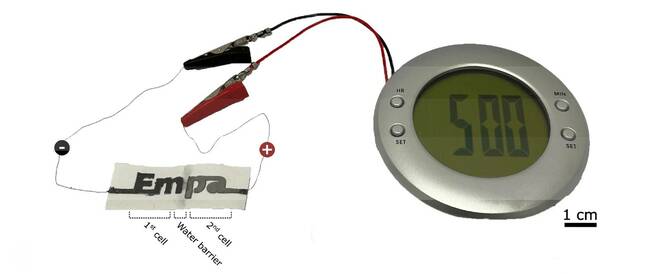This article is more than 1 year old
Paper batteries on the cards to power IoT and smart labels
Quest to reduce environmental impact finds pulp solution
Scientists in Switzerland have developed a battery made out of paper which will release its charge when splattered with water.
The developers claim it could be a novel solution to power disposable electronics such as smart labels for tracking objects, environmental sensors and medical diagnostic devices.

Photograph of a stencil-printed paper battery with a design that spells the name of our research institution (Empa). The battery can run low-power electronics like the liquid crystal display (LCD) alarm clock shown in this photograph. Illustration: Nyström et al (click to enlarge)
Gustav Nyström, head of the Laboratory for Applied Wood Materials at the Swiss Federal Laboratories for Materials Science and Technology (Empa), worked with his colleagues to produce the single cell battery made from a single centimeter-square piece of paper impregnated with sodium chloride salt.
Printed onto the paper are three inks. On one side researchers printed ink containing graphite flakes to form a positive terminal or cathode. On the other side, ink containing zinc powder makes up the negative or anode end of the energy storage device.
A third ink, containing graphite flakes and carbon black is printed on both sides of the paper, on top of the other two inks, forming a connection between each end of the battery and two wires. The connected ends of the battery are impregnated with wax to avoid electrochemical reactions of the lead wires and to provide mechanical stability.
To harvest electrical energy from the device, an operator must introduce a small amount of water dissolving the salt in the paper and thereby releasing charged ions which disperse through the paper causing the zinc ink anode to release electrons. Attaching the wires to an electrical device, the operator can close the circuit. Electrons move from the anode to the cathode via the graphite and carbon black connecting ink, the wires and the device which is powered by the discharge.
- Trees may help power your next electric car
- Intel bags deal to make chips for MediaTek, that other Android processor designer
- Edge compute, AI on track for meteoric growth – or so these predictions say
- Amazon's AI chips find their way into Astro butler bot, latest wall-hanging display
Just don't expect it to power a cordless drill. Twenty seconds after adding two drops of water the battery reaches a stable 1.2 volts, a little less than 1.5 volt AA battery. The charge lasts about an hour, after which the paper dries out. Users can get another hour at 0.5 volts by adding a couple more drops of water.
“Over the last decades, we have witnessed an ever-increasing use of electronic devices, leading in turn to electronic waste (e-waste) becoming the world’s fastest growing waste stream. Mitigating the associated environmental risks requires advances at the material and device levels, for instance by moving towards more environmentally friendly materials and improving the resource recovery rate,” the authors said in a paper published in Nature Scientific Reports.
The paper concluded: “Our battery is … relevant for wide range of low-power electronics and the IoT ecosystem. This work advances the field of disposable electronics and presents a battery technology that balances environmental impact and performance,” they said. ®
